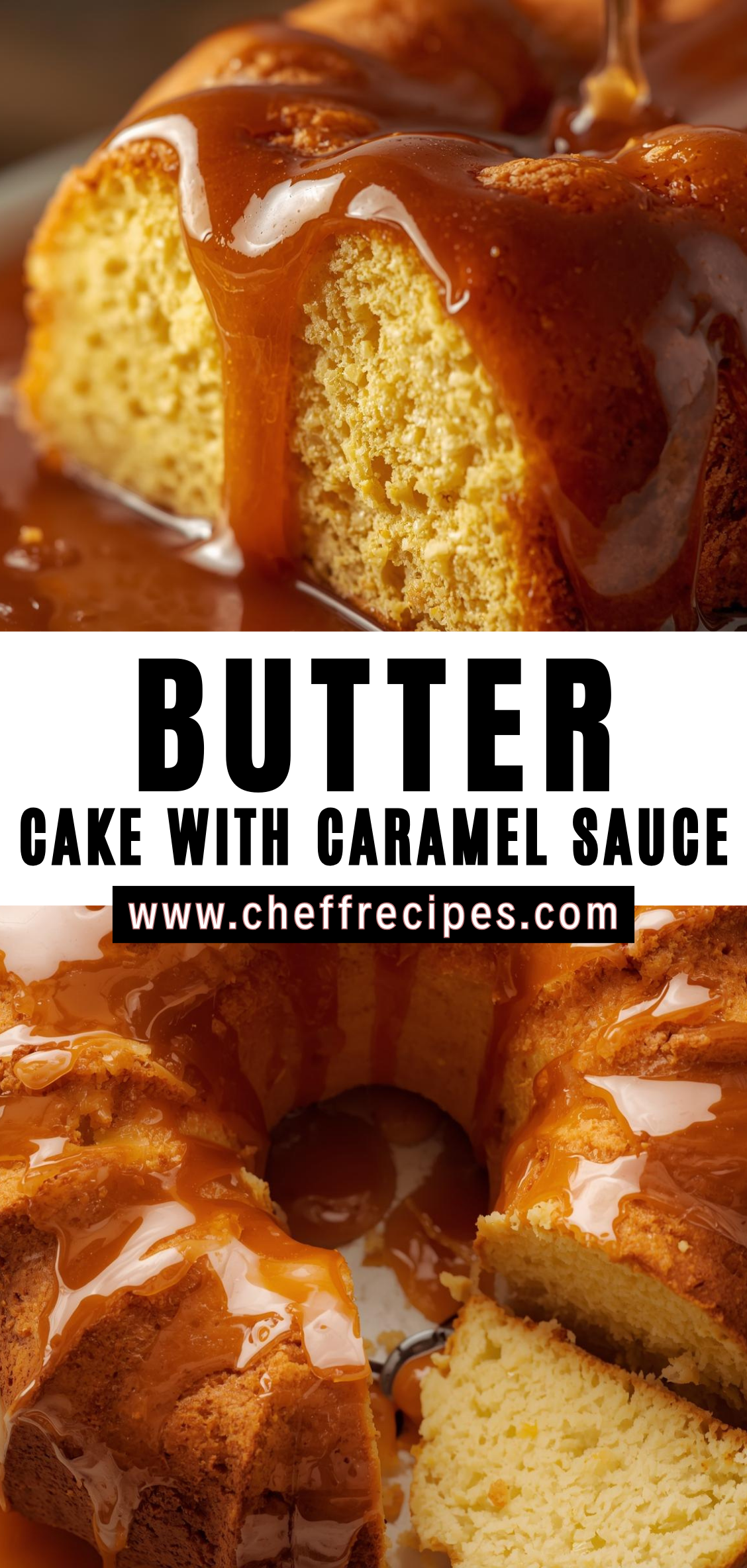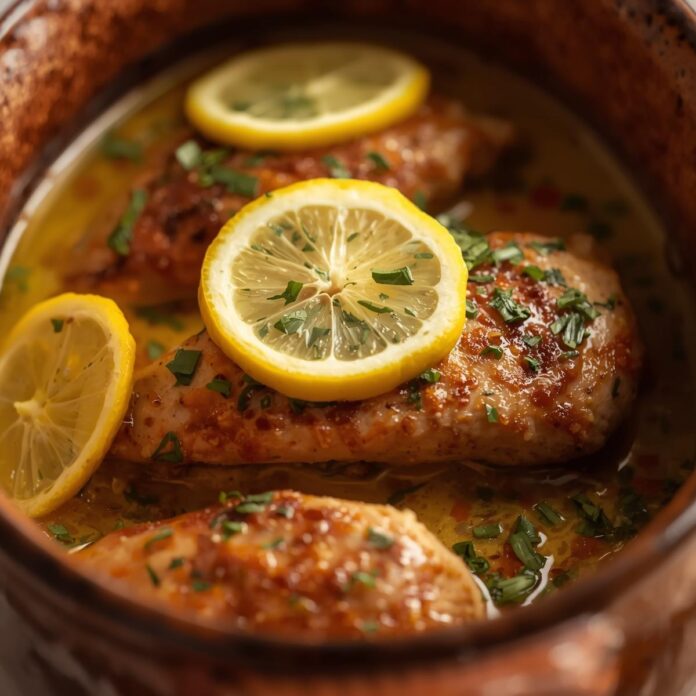There are some desserts that announce themselves quietly yet leave a lasting echo in the memory, and butter cake with caramel sauce is one of them. It is not the sort of dessert that relies on extravagance or novelty to impress. Instead, it leans on the timeless appeal of familiar ingredients—flour, sugar, butter, cream—and transforms them into something far greater than the sum of their parts. It is a dessert built on comfort, nostalgia, and straightforward technique, yet it rewards the baker with a depth of flavor that feels almost luxurious. The tenderness of the crumb, the richness of the butter, and the deep sweetness of caramel come together in a way that feels both homey and indulgent, making it an ideal centerpiece for gatherings or a quiet afternoon treat.

Butter cake itself has a long and widespread heritage, appearing in various forms across cultures and generations. Its earliest iterations were simple, almost austere, made at a time when ingredients were precious and every step in the baking process mattered. Over time, as baking powder and refined sugars became more widely available, the cake evolved into the lighter, airier dessert many know today. But regardless of regional interpretation—whether dense and velvety, tall and fluffy, or enriched with extra egg yolks—the defining character of butter cake remains consistent: it should melt on the tongue while still offering structure, richness, and a comforting sweetness. It is a cake that invites slow, appreciative bites rather than hurried consumption.
Caramel sauce, too, brings with it a sense of culinary tradition. Its origins are rooted in the simple act of heating sugar until it transforms into something almost magical. Watching grains of sugar dissolve, darken, and finally transform into a fragrant amber liquid is one of the clearest demonstrations of the alchemy of cooking. Caramel can be temperamental—too little heat and it is flat and sugary; too much and it veers into bitterness. But when handled with patience and precision, it becomes a complex symphony of sweetness, warmth, and faintly smoky undertones. When combined with cream and butter, caramel’s sharp edges soften, producing a sauce that flows luxuriously and clings gently to whatever it touches.
When butter cake and caramel sauce meet, something remarkable happens. The cake acts as a canvas, tender yet sturdy, absorbing the warmth and moisture of the caramel without collapsing. Every slice becomes an interplay of textures: the soft crumb, the glossy ribbon of sauce, and perhaps even the slight crispness of the cake’s golden edges. The flavors intertwine as well—the pure, buttery richness of the cake merges with the deeper, almost toffee-like notes of caramel, resulting in a harmony that is both comforting and sophisticated.
This recipe aims to honor that timeless combination by focusing on quality, technique, and balance. It is designed not merely as a set of instructions, but as a narrative guide that helps you understand the reasons behind each step. The goal is to give you a cake that rises evenly, stays moist for days, and tastes even better on the second or third day as the flavors settle and deepen. Likewise, the caramel sauce here is crafted to be smooth, glossy, and versatile—thick enough to coat the back of a spoon yet fluid enough to drizzle over a slice of cake without overwhelming it. By mastering these two components, you gain not only one excellent dessert but also the foundations for countless variations.
Whether you are baking for a celebration, experimenting in your kitchen, or simply seeking a dessert that embodies warmth and familiarity, this butter cake with caramel sauce offers something truly satisfying. It is a reminder that some of the best culinary experiences come not from complexity or novelty, but from reconnecting with the classics and doing them exceptionally well. In the sections that follow, we will explore each step of the process in detail—from selecting ingredients to understanding mixing techniques, from achieving the ideal caramel color to serving the cake at its best. With patience and care, you will find that this dessert is as enjoyable to create as it is to share.
DETAILED INSTRUCTIONS
1. Preparing Your Workspace
Before any mixing begins, take a moment to set up your kitchen properly. A well-organized workspace improves consistency and reduces mistakes, especially in a recipe where timing and temperature matter. Clear your countertops, ensure your oven racks are positioned in the center, and gather your equipment: mixing bowls, a stand mixer or hand mixer, measuring cups, digital scale if you have one, rubber spatula, offset spatula, whisk, saucepan, and your cake pan. Line the pan with parchment and lightly coat it with butter and flour. This prevents the cake from adhering to the sides and guarantees a smooth release.
Place your ingredients on the counter so they can come to room temperature. Butter should be soft enough to yield to gentle pressure but not so warm that it appears greasy or melted. Eggs should lose their chill; cold eggs do not incorporate evenly into creamed butter and can cause curdling. Milk should also rest outside the refrigerator long enough to remove the edge of coldness. These temperature considerations might appear small, but they dramatically influence the texture of the final cake.
2. Preheating the Oven
Set your oven to 350°F (177°C). Full preheating is crucial, as butter cakes rely on the initial burst of heat to help the batter rise. Underheated ovens cause dense, heavy cakes. Allow the oven to heat for at least 20 minutes to ensure an even internal temperature.
3. Creaming the Butter and Sugar
Place the softened butter into the bowl of your stand mixer. Begin beating on medium speed, allowing the paddle to move through the butter until it becomes smooth and pale. This step incorporates air into the fat, creating microscopic pockets that expand in the heat of the oven, producing the tenderness and lightness characteristic of a well-made butter cake.
Once the butter is light and creamy, gradually add the granulated sugar. Add it slowly—one or two tablespoons at a time—giving the mixer time to work the crystals into the fat. Avoid dumping all the sugar at once; doing so inhibits proper aeration. Continue to cream the mixture for 3 to 5 minutes, stopping occasionally to scrape down the bowl. The finished mixture should be noticeably paler and increased in volume.
4. Adding the Eggs
Crack your eggs into a separate small bowl to ensure no shell fragments remain. With the mixer running on low to medium-low, add the eggs one at a time. Each egg should be fully incorporated before the next is added. Rushing this process can cause the mixture to separate or curdle, which affects the cake’s rise and crumb structure.
After the last egg is added, beat the mixture for an additional minute. The batter should be smooth, silky, and cohesive. If you notice slight curdling, do not panic; it will often resolve itself once the dry ingredients are incorporated.
5. Combining Dry Ingredients
In a separate bowl, whisk together your flour, baking powder, and salt. This step is not just to blend the ingredients—it aerates the flour and breaks up any clumps. Use a fine whisk rather than a spoon, as whisking better distributes the leavening. Keep this bowl nearby, as the next step requires alternating between dry and wet components.
6. Incorporating the Dry Ingredients and Milk
Reduce the mixer speed to low. Add one-third of the dry mixture to the batter, allowing it to fold in gently. Do not overmix; flour develops gluten when worked too vigorously, and too much gluten leads to a tougher crumb. Once the first third is incorporated, add half of the room-temperature milk. Allow the milk to blend smoothly before adding the next portion of flour.
Continue alternating: dry ingredients, milk, dry ingredients, until all are incorporated. End with the flour mixture, as finishing with dry ingredients helps maintain structure. Scrape the bowl with a rubber spatula to ensure no streaks of flour remain.
7. Adding Flavoring and Ensuring Proper Texture
Pour in your vanilla extract. Fold gently by hand to ensure even distribution. At this stage, examine the batter’s consistency. It should be thick enough to hold shape when lifted with a spatula but soft enough to fall slowly back into the bowl. If the batter appears unusually stiff, the butter may have been too cold or the flour measurement too heavy; add a tablespoon of milk to adjust.
8. Filling the Cake Pan
Spoon the batter into your prepared pan. Use the spatula to spread it evenly from edge to edge. Smooth the top and gently tap the pan against the counter to release trapped air bubbles. This step prevents large pockets from forming inside the cake.
9. Baking the Cake
Place the pan in the center of the oven. Bake for 35 to 45 minutes, depending on your oven and the thickness of your pan. Avoid opening the oven door during the first 25 minutes; the sudden drop in temperature can cause the cake to sink.
Begin checking the cake at the 35-minute mark. Insert a toothpick into the center; it should come out clean or with a few moist crumbs. The surface should be golden, and the cake should spring back lightly when touched.
10. Cooling the Cake Properly
Remove the pan from the oven and let it cool on a wire rack for 10 to 15 minutes. Cooling inside the pan allows the cake to firm slightly, making it easier to release without breaking.
After this brief rest, run a thin knife around the edges and turn the cake out onto the rack. Peel off the parchment paper and allow the cake to cool completely. Cooling is essential before adding caramel sauce; warm cake will absorb the sauce too quickly, altering the intended presentation and texture.
MAKING THE CARAMEL SAUCE
11. Preparing the Ingredients
Measure your sugar, cream, butter, and salt. Keep them close to your stovetop so you can reach them quickly. Caramel moves fast, and hesitation can lead to burning.
12. Heating the Sugar
Place the sugar in a heavy-bottomed saucepan. Use medium heat and allow the sugar to warm slowly. It will begin to melt at the edges first, turning clear and then amber. Use a heat-resistant spatula to gently push the melted sugar toward the center. Avoid stirring vigorously; this can cause crystallization.
Continue heating until the melted sugar reaches a deep golden color. A light amber yields a sweeter, milder caramel, while a darker amber produces a more intense, slightly bitter complexity. Choose according to your preference, but remain attentive. Caramel can go from perfect to burnt in seconds.
13. Adding the Butter
Once the sugar reaches your desired color, add the butter. The mixture will bubble vigorously. Stir gently and continuously until the butter melts completely and becomes smooth. Keep your face and hands clear of the steam, as it can be extremely hot.
14. Incorporating the Cream
Slowly pour in the cream while stirring. The mixture will foam up once more, then settle as the cream incorporates. Continue cooking for another minute, allowing the sauce to thicken slightly. The caramel will appear thinner while hot but will thicken as it cools.
15. Adjusting Flavor
Remove the pan from heat. Add a pinch of salt or more if you prefer a salted caramel profile. Taste carefully once slightly cooled. If the sauce is too thick, add a splash of warm cream; if too thin, return it to the heat and simmer briefly.
16. Cooling and Storing the Sauce
Allow the caramel to cool before pouring it into a heatproof jar. Store at room temperature for several hours, or refrigerate for longer keeping. Reheat gently before serving.
Butter Cake with Caramel Sauce
There are some desserts that announce themselves quietly yet leave a lasting echo in the memory, and butter cake with caramel sauce is one of them. It is not the sort of dessert that relies on extravagance or novelty to impress. Instead, it leans on the timeless appeal of familiar ingredients—flour, sugar, butter, cream—and transforms them into something far greater than the sum of their parts. It is a dessert built on comfort, nostalgia, and straightforward technique, yet it rewards the baker with a depth of flavor that feels almost luxurious. The tenderness of the crumb, the richness of the butter, and the deep sweetness of caramel come together in a way that feels both homey and indulgent, making it an ideal centerpiece for gatherings or a quiet afternoon treat.
Ingredients
- Butter Cake:
- 1 cup (226 g) unsalted butter, softened
- 1 cup (200 g) granulated sugar
- 4 large eggs, room temperature
- 2 cups (250 g) all-purpose flour
- 2 tsp baking powder
- ½ tsp fine salt
- ½ cup (120 ml) whole milk, room temperature
- 2 tsp vanilla extract
- Caramel Sauce:
- 1 cup (200 g) granulated sugar
- 6 tbsp (85 g) unsalted butter, cubed
- ½ cup (120 ml) heavy cream, warmed
- ¼ tsp salt (optional, for salted caramel)
Instructions
Make the Butter Cake
- Prep: Preheat oven to 350°F (175°C). Grease and flour an 8-inch (20 cm) round or square pan.
- Cream: In a mixing bowl, beat butter and sugar together until light and fluffy (about 3–4 minutes).
- Add eggs: Add eggs one at a time, beating well after each addition. Mix in vanilla.
- Dry ingredients: In a separate bowl, whisk together flour, baking powder, and salt.
- Combine: Add dry ingredients to the butter mixture in 2–3 additions, alternating with the milk. Mix just until smooth.
- Bake: Pour batter into prepared pan. Bake 35–40 minutes, or until a toothpick inserted in the center comes out clean.
- Cool: Let the cake cool in the pan for 10 minutes, then turn out onto a rack to cool completely.
Make the Caramel Sauce
- Melt sugar: In a medium heavy saucepan over medium heat, heat sugar until it melts and turns an amber color. Stir occasionally once it begins to liquify.
- Add butter: Add butter carefully (it will bubble). Stir until melted.
- Add cream: Slowly pour in the warm cream while stirring. Allow to boil for 1 minute.
- Season: Add salt if desired.
- Cool: Remove from heat. Let cool 10–15 minutes before serving.
To Serve
Slice butter cake and drizzle generously with warm caramel sauce.
Notes
- Be sure butter and eggs are room temperature for the fluffiest texture.
- Do not overmix once the flour is added—this keeps the cake tender.
- Caramel sauce thickens as it cools; warm gently if it becomes too thick.



